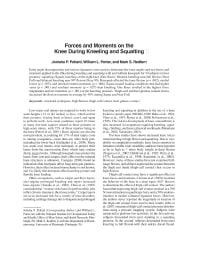Mining Publication: Forces and Moments on the Knee During Kneeling and Squatting
Original creation date: August 2011
Authors: JP Pollard, WL Porter, MS Redfern
Euler angle decomposition and inverse dynamics were used to determine the knee angles and net forces and moments applied to the tibia during kneeling and squatting with and without kneepads for 10 subjects in four postures: squatting (Squat), kneeling on the right knee (One Knee), bilateral kneeling near full flexion (Near Full) and bilateral kneeling near 90° flexion (Near 90). Kneepads affected the knee flexion (p = .002), medial forces (p = .035), and internal rotation moments (p = .006). Squat created loading conditions that had higher varus (p < .001) and resultant moments (p = .027) than kneeling. One Knee resulted in the highest force magnitudes and net moments (p < .001) of the kneeling postures. Thigh-calf and heel-gluteus contact forces decreased the flexion moment on average by 48% during Squat and Near Full.

- Demands on the Knee During Kneeling and Squatting Activities Common to Low-seam Mining
- Development and Evaluation of Prototype Kneepads for the Low-Seam Mining Industry
- Electromyography of the Thigh Muscles during Lifting Tasks in Kneeling and Squatting Postures
- Evaluation of Muscle Activity, Forces, Stresses, and Moments at the Knee During Kneeling and Squatting Tasks
- Keeping Knees Healthy in Restricted Work Spaces: Applications in Low-Seam Mining
- Pressure Distribution on the Anatomic Landmarks of the Knee and the Effect of Kneepads
- Pressures Applied to Anatomical Landmarks of the Knee While in Kneeling Postures
- Task-Specific Postures in Low-Seam Underground Coal Mining
- Thigh-Calf and Heel-Gluteus Contact Forces in High Flexion: Experimental Results
- Working in Unusual or Restricted Postures